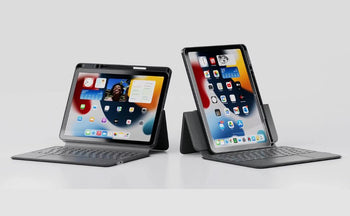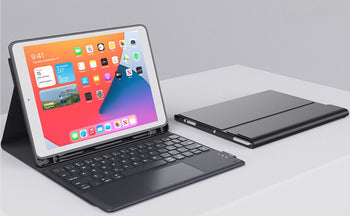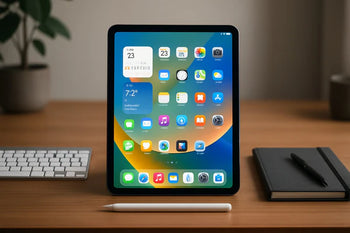Seeing "iPad is disabled" pop up can be a real headache, especially if you’re in a hurry. That message shows up when you enter the wrong passcode too many times, and your iPad locks you out to keep your info safe.
You can fix a disabled iPad by putting it in recovery mode and restoring it through a computer. This wipes out the passcode and lets you set everything up again. Just a heads up: this erases your data, but if you’ve backed up, you can get it all back.
Thankfully, fixing this issue isn’t rocket science once you know what to do. Here’s what’s going on, how to unlock your iPad quickly, and a few tips to avoid getting locked out again.
Shield your iPad from drops and scratches with a rugged heavy-duty iPad case built for long-lasting protection.
Why Your iPad Is Disabled

Your iPad disables itself when Apple’s security features kick in to stop unauthorized access. Usually, it’s from entering the wrong passcode too many times, but sometimes it happens after updates or cloud sync problems.
Too Many Wrong Passcode Attempts
The most common reason? Punching in the wrong passcode over and over. Apple set this up to keep people from guessing your code endlessly.
Here’s how the lockout works:
|
Wrong Attempts |
Result |
|
5 attempts |
iPad disabled for 1 minute |
|
6 attempts |
iPad disabled for 5 minutes |
|
7 attempts |
iPad disabled for 15 minutes |
|
8 attempts |
iPad disabled for 60 minutes |
|
10 attempts |
iPad permanently disabled |
After 10 failed tries, you’re locked out for good—no waiting it out this time.
Every wrong entry counts, even if you’re sure you typed it right. Sometimes updates tweak touch sensitivity, and suddenly your usual code doesn’t go through like it used to.
Security Lockout After Software Update Or Reset
Sometimes you’ll see an iPad unavailable message or security lockout screen after updating iOS or resetting. This can happen if the system can’t verify your identity properly.
If the update process gets interrupted, your iPad might think someone’s trying to bypass security. Factory resets can do it too—your device wants to make sure it’s really you before letting you back in.
Face ID or Touch ID glitches after updates can mean you’re stuck using your passcode, and if you mess it up, here comes the lockout.
When iTunes Or iCloud Lock You Out For Safety
iTunes and iCloud have their own ways of locking you out if something seems off. They work with your device to keep your data protected from different angles.
If someone tries to restore your iPad in iTunes without the right credentials, you might get locked out. It’s a good thing—this stops thieves from wiping your device and using it.
Marking your iPad as lost in iCloud triggers a lockout too. The device stays off-limits until you unlock it the right way.
Activation Lock can make your iPad look disabled if your Apple ID gets locked or you sign out of iCloud the wrong way.
If you have several devices on the same Apple ID and iCloud sees odd activity, it might lock things down to protect you.
How To Fix A Disabled iPad Step-By-Step

You’ve got three main ways to fix a disabled iPad: restore it with Finder or iTunes on a computer, use iCloud’s Find My iPad remotely, or put it in recovery mode. All of these erase your iPad and remove the passcode.
Use Finder Or iTunes To Restore Access
Plug your disabled iPad into a Mac or Windows PC using a USB cable. You’ll need Finder (on macOS Catalina or newer) or iTunes (older Macs or Windows).
Open Finder or iTunes. Your iPad should show up in the sidebar or device list. If the computer asks for your passcode, try another computer or recovery mode.
Click your iPad. You’ll get options to Restore or Update.
Pick Restore iPad. This downloads the latest iPadOS and wipes your device. It usually takes between 15 and 60 minutes, depending on your internet speed.
Once it’s done, your iPad restarts with the "Hello" screen. Set it up as new or restore from a backup.
Heads up: This only works if you’ve trusted this computer before. Otherwise, use recovery mode.
Unlock With iCloud's Find My iPad Feature
Sign in to iCloud.com from any device with your Apple ID—the same one linked to your iPad.
Open Find My from the menu. You’ll see your devices on a map.
Select your disabled iPad. If it’s online, you’ll see its location.
Hit Erase iPad. This wipes your iPad remotely and removes the passcode. You’ll have to confirm.
Wait for the process to finish. Your iPad restarts and shows the setup screen.
What you need for this:
- Find My iPad turned on
- Your iPad connected to the internet
- Your Apple ID and password
This method is perfect if your iPad’s at home and you’re not.
Use Recovery Mode If You Forgot The Passcode
First, turn your iPad off. On models without a home button, hold a volume button and the top button until the power slider appears. On older ones, just hold the top button.
Slide to power off. Wait at least a minute.
Plug your iPad into a computer with a USB cable. Leave it connected.
To enter recovery mode:
For iPads without a home button:
- Quickly press and release volume up
- Quickly press and release volume down
- Hold the top button
For iPads with a home button:
- Hold both the home and top buttons together
- Keep holding until you see the computer and cable icon—don’t let go at the Apple logo.
- On your computer, open Finder or iTunes. Click Restore when prompted. The software will download and restore your iPad.
What To Do If None Of These Work
If these fixes don’t work, head to an Apple Store or an authorized repair shop. Your iPad might have hardware problems blocking recovery.
If you have AppleCare+ or your warranty’s still good, Apple might repair or swap your device for free.
Try swapping out USB cables or using different computer ports—sometimes it’s just a bad connection.
Make sure your software’s up to date. Update iTunes on Windows or check for the latest macOS on your Mac.
If you’re stuck, try this:
- Borrow another computer if yours won’t cooperate
- Wait a day and try again if you get a long lockout
- Contact Apple Support for help
All these methods erase your iPad. If you have a backup, use it to get your stuff back.
Prevent Your iPad From Getting Disabled Again
The best way to avoid this mess? Use Face ID or Touch ID, and always keep backups. It sounds simple, but it really saves you time and stress.
Set Up Face ID Or Touch ID For Easier Access
Face ID and Touch ID save you from having to remember tricky passcodes. Just your face or fingerprint and you’re in.
For Face ID, go to Settings > Face ID & Passcode. Hold your face in the camera and move your head in a circle. The iPad scans you from all angles.
For Touch ID, head to Settings > Touch ID & Passcode. Tap your finger on the Home button a few times so it can learn your print.
Why bother with biometrics?
- No more forgotten codes
- Unlocks in a flash
- Less chance of locking yourself out
- Touch ID even works with messy fingers
You can store up to five fingerprints, so others can use the iPad without needing your code.
Keep Your iPad Backed Up To iCloud Or iTunes
Backups are a lifesaver. If you don’t back up, you’ll lose all your photos, apps, and files when you reset a disabled iPad.
iCloud backup runs automatically over Wi-Fi. Just turn it on in Settings > [Your Name] > iCloud > iCloud Backup. Your iPad backs up daily when it’s plugged in and locked.
If you want more control, use iTunes backup. Connect your iPad to your computer, open iTunes or Finder, select your device, and hit Back Up Now.
What gets saved?
- Photos and videos
- App data
- Messages and call logs
- Settings and preferences
Double-check your backup dates in Settings > [Your Name] > iCloud to make sure you’re covered.
Protect Your Device With A Quality Case And Keyboard
A good case keeps your iPad safe from accidental touches that might trigger wrong passcodes. Plus, it guards against drops and bumps.
Screen protectors help prevent phantom touches from cracked screens. Damaged glass sometimes registers random taps, which can lock you out.
Keyboard cases cover the screen when you’re not using your iPad, so nothing in your bag presses random buttons.
Smart covers lock your iPad when closed, cutting down on accidental wake-ups.
Look for cases with raised edges to keep the screen off surfaces when you set it face-down.
Work smarter and faster with a responsive iPad keyboard and mouse set designed for comfort and precision.
Get The Right Accessories To Keep Your iPad Safe
Honestly, the right accessories make a big difference. Good cases and keyboards can help you avoid the hassle of a disabled iPad by protecting it from damage and accidental passcode attempts.
Use Chesona's Keyboard Cases For Secure, Productive Use
Keyboard cases aren’t just about boosting productivity. They also protect your iPad’s screen when closed and help keep those accidental touches from triggering passcode attempts. That’s especially handy if you’re someone who’s always on the go or a bit clumsy (no judgment).
Chesona’s keyboard cases wrap snugly around your iPad, blocking out dust and debris from ports and buttons. Clean ports mean you’re less likely to run into connection hiccups when you need to use the Apple Devices app for recovery. It’s the kind of detail you don’t notice until you really need it.
Key Benefits:
- Screen Protection: Keyboard acts as a barrier when closed
- Stable Typing: Fewer accidental screen taps
- Port Coverage: Keeps charging ports clean for reliable connections
The cases fit all iPad models, including iPad Pro. You can adjust them for multiple viewing angles, so you’re not always fiddling with your device to get comfortable. Less time adjusting, more time actually getting things done—sounds good, right?
If you use your iPad for work, these cases make a difference. The stable keyboard helps cut down on errors when you’re typing passwords or passcodes. Fewer mistakes, less risk of disabling your device. Simple but effective.
Protect Your Screen From Damage With A Heavy-Duty Case
Screen damage is one of the top reasons iPads get disabled. Cracks can mess with touch recognition, leading to failed passcode attempts and eventual lockouts. Nobody wants that headache.
Heavy-duty cases soak up impact from drops and bumps. With reinforced corners (where most accidents happen) and raised edges, your screen stays safer—even if you toss your iPad down on a table a little too hard.
Protection Features:
- Drop Protection: Up to 6 feet for most models
- Scratch Resistance: Keeps screen smooth and responsive
- Water Resistance: Guards against spills and moisture
You’ll still have full access to every button and port. Charging and connecting to a computer? No need to remove the case. That’s important if you ever have to use iTunes or the Apple Devices app for recovery.
The clear back panels let you show off your iPad’s design. So you get solid protection without hiding the look you picked out in the first place.
Explore Chesona's Accessories For Every iPad Model
Not every iPad needs the same level of protection. The iPad Pro, with its bigger screen, usually calls for a tougher case. Standard iPads? They’re fine with something lighter and easier to carry.
Chesona makes model-specific accessories that actually fit. Each case lines up with your iPad’s ports and buttons, so you’re not fighting with your gear. That precision means your case never gets in the way of normal use.
Available Options:
- iPad Pro Cases: Extra reinforcement for bigger screens
- Standard iPad Cases: Balanced protection and portability
- Mini iPad Cases: Compact protection for smaller devices
All the accessories work smoothly with recovery processes. If you ever need to restore your iPad using the Apple Devices app, you’ll have full connectivity. No awkward trade-offs between protection and function.
Many cases also use magnetic closures to prevent accidental wake-ups. That helps cut down on battery drain and random screen activity that could cause passcode headaches.
Keep your device protected and perfectly positioned with iPad cases with stand made for work, travel, and streaming.
Conclusion: iPad is Disabled
Getting locked out with an “iPad is disabled” message can be stressful, but most of the time, it’s fixable with the right steps. Whether you restore through iTunes, iCloud, or recovery mode, you can usually get your device working again without too much hassle.
Once you’re back in, set up Face ID or Touch ID and keep regular backups to prevent future lockouts. A little preparation goes a long way in keeping your iPad secure and running smoothly.
Next up: How to Update Apps on iPad
Frequently Asked Questions
People often wonder why their iPad suddenly locks up or how to get back in quickly. Here are some of the most common questions about disabled iPads and how to restore access.
Why is my iPad suddenly disabled?
Your iPad becomes disabled after too many wrong passcode attempts. Apple’s security system locks it to protect your data. Each failed try increases the wait time until the device locks completely.
How do I get my iPad out of disabled mode?
Use recovery mode with a computer and USB cable to restore your iPad. Connect it to iTunes or Finder and choose “Restore” when prompted. This erases the device, but you can recover your data from a backup afterward.
How to reboot an iPad when disabled?
You can’t reboot a disabled iPad normally—it must go into recovery mode. Turn it off completely, then connect it to a computer. Hold the correct buttons until the recovery mode screen appears.
How to unlock your iPad when it says iPad is unavailable?
“iPad unavailable” means too many wrong passcode attempts. Connect your iPad to a computer, enter recovery mode, and select “Restore.” Once reset, you can set it up again and create a new passcode.



















